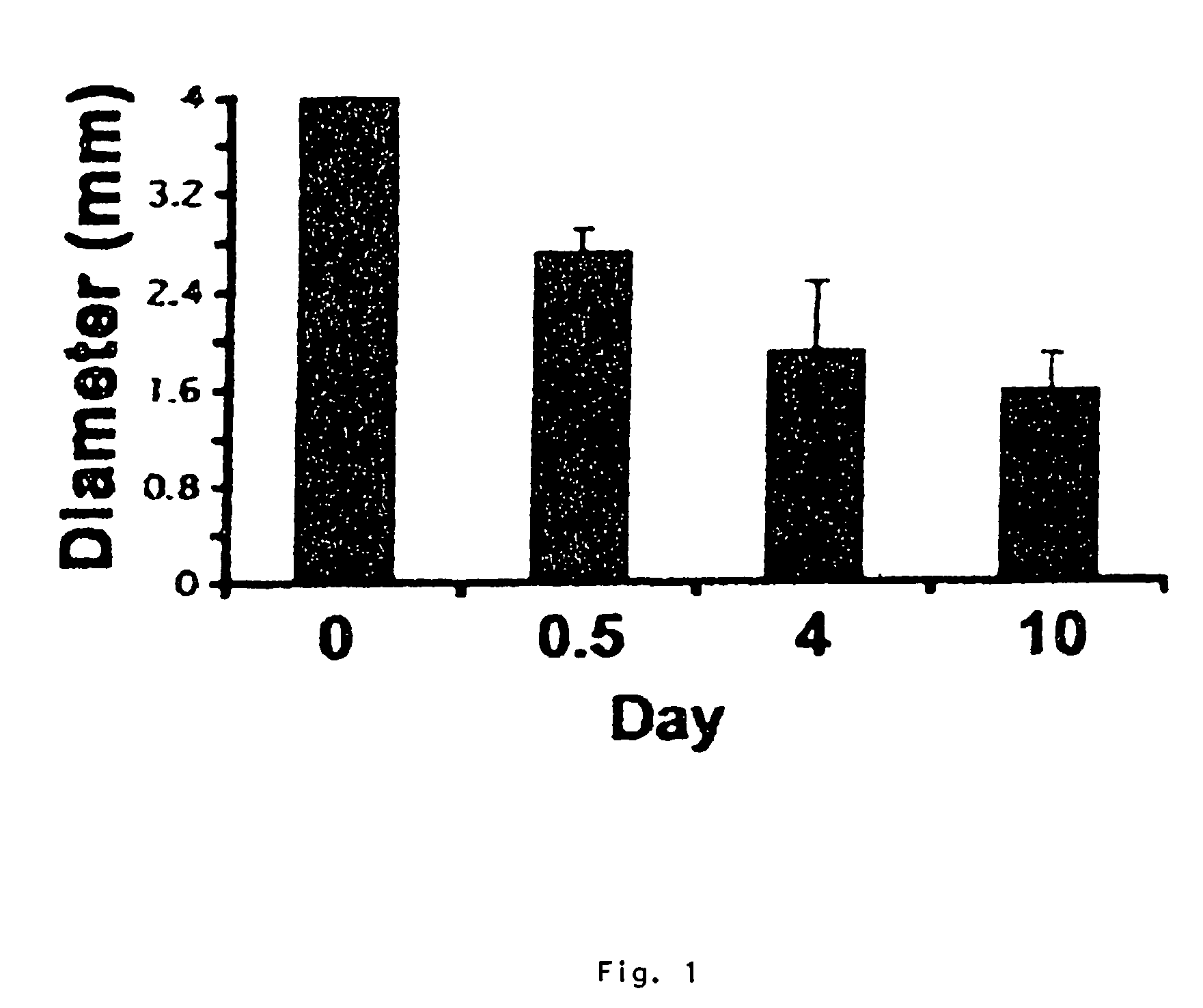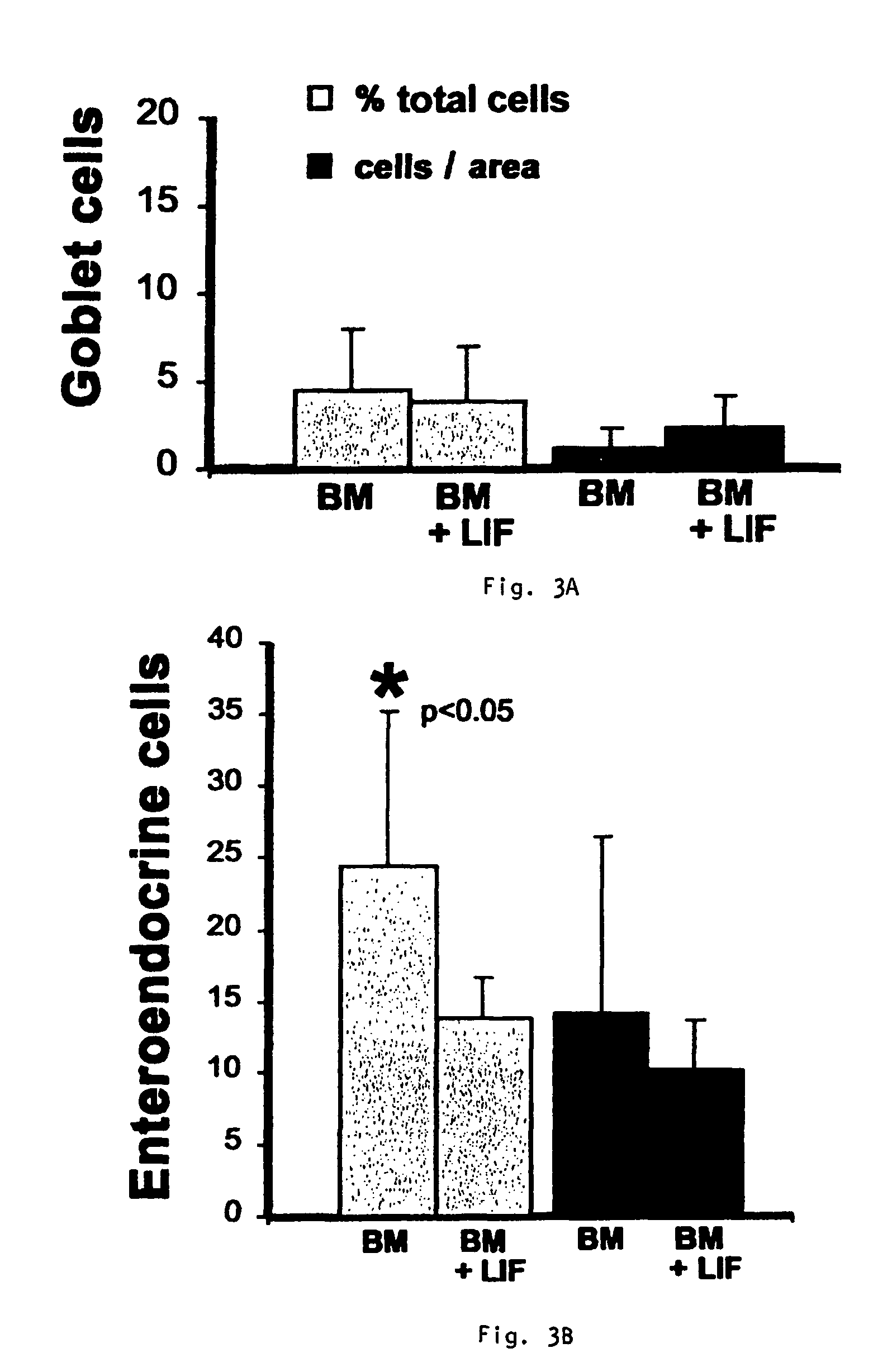Organotypic intestinal culture and methods of use thereof
a technology of intestinal culture and culture method, which is applied in the field of organotypic intestinal culture, can solve the problems of limited biological studies of proliferation and differentiation, difficult to maintain normal human colonic epithelial cells in vitro, and limit the use of their usefulness for biological studies, so as to promote the repair of the epithelial cell layer
- Summary
- Abstract
- Description
- Claims
- Application Information
AI Technical Summary
Benefits of technology
Problems solved by technology
Method used
Image
Examples
example 1
Preparation of Organotypic Cultures
[0101]A. Cells
[0102]Human colonic fibroblasts were established from explants of colons from 7- to 20-week-old fetuses of therapeutic or spontaneous abortions. The colonic explants were obtained through Advanced Bioscience Resources (Alameda, Calif.), after approval by the Institutional Review Board. Out of three fibroblast cell lines established from these explants, FFC331 was used for most of these studies. The fibroblasts were cultured in Dulbecco's modified minimum essential medium (DMEM, GIBCO BRL, Rockville, Md.) supplemented with 10% fetal calf serum (FCS, Cansera, Rexdale, Ontario, Canada) and antibiotics. Cultures were used up to passage 10.
[0103]Human smooth muscle cells (HIAS 119) were isolated from large vessels and maintained in medium M199, supplemented with 10% FCS, 2 mM L-glutamine, and 50 μg / ml of bovine hypothalamic extract (Sorger, T. et al. 1995 In Vitro Cell Dev. Biol. Anim., 31:671–683).
[0104]Human enteric epithelial cells were...
example 2
Growth Factor Modulation of the Epithelial Phenotype
[0122]To define the role of critical growth factors supporting growth and differentiation of the enteric epithelial cells, an organotypic culture, such as that described in Example 1, was grown in medium in which the number of supplements was reduced.
[0123]In one experiment the base medium (MCDB 201 / L15 medium with transferrin and antibiotics) was supplemented with EGF and insulin. In the resulting organotypic culture on day 3, undifferentiated colonic epithelial cells attached to the artificial stroma, but they were not polarized. On day 7, in the presence of EGF and insulin, viable, non-polarized, epithelial cells survived in isolated small clusters with round-shaped undifferentiated morphology on the artificial stroma.
[0124]In other experiments, the growth factors, including insulin, EGF, SCF, ET-3, KGF, bFGF, or AMF were added individually to the base medium (MCDB 201 / L15 medium with transferrin and antibiotics). In each case, ...
example 3
Role of Extracellular Matrix (ECM)
[0129]Another embodiment of an organotypic culture prepared as described substantially as in Example 2, has an additional component. An extracellular matrix was applied to the organotypic cultures by coating the artificial stroma with matrix proteins Laminin-2 α2β1γ1 (Life Technologies, Rockville, Md.), Laminin-1 α2β1γ1 (Sigma), or Matrigel® gel matrix (Collaborative Research, Bedford, Mass.), which contains Laminin-1 and other matrix proteins, such as collagen IV and nitrogen (Burgeson, R E., et al. 1994 Matrix Biol., 14:209–211 and Page, KC. et al. 1990 J. Biol. Reprod., 43:659–664).
[0130]Fifty to 100 μl of base medium containing 20 ng / ml of laminins were added onto the surface of the artificial stroma for 60 minutes at 37° C. Matrigel® matrix was diluted 1:5 to 1:10 in base medium before use. After incubation, unbound laminins or Matrigel® matrix were removed by two washings with base medium. The organotypic cultures were incubated at 37° C. in 5...
PUM
| Property | Measurement | Unit |
|---|---|---|
| concentration | aaaaa | aaaaa |
| pH | aaaaa | aaaaa |
| length | aaaaa | aaaaa |
Abstract
Description
Claims
Application Information
 Login to View More
Login to View More - R&D
- Intellectual Property
- Life Sciences
- Materials
- Tech Scout
- Unparalleled Data Quality
- Higher Quality Content
- 60% Fewer Hallucinations
Browse by: Latest US Patents, China's latest patents, Technical Efficacy Thesaurus, Application Domain, Technology Topic, Popular Technical Reports.
© 2025 PatSnap. All rights reserved.Legal|Privacy policy|Modern Slavery Act Transparency Statement|Sitemap|About US| Contact US: help@patsnap.com



